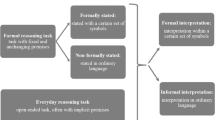Abstract
The present note discusses a new view of the institution as a nested structure of reciprocal reasoning. To explain the emergence of a Nash equilibrium, Aumann assumed common knowledge of the conjectures of agents with respect to strategy spaces. In the present note, we demonstrate that common knowledge can be defined by knowledge and infinite reasoning. However, recent studies in experimental economics, suggest that the assumption of infinite reciprocal reasoning is, in most cases, neither empirically relevant nor necessary for achieving a Nash equilibrium. Moreover, we demonstrate that reasonable states, which are composed of non-Nash equilibrium strategies, are attained only by bounded reasoning agents. Furthermore, this view of the institution is applied to examples such as Bentham’s Panopticon and the depth of reasoning in the institution is examined.
Similar content being viewed by others
References
Aoki, M. (2001) Toward a Comparative Institutional Analysis (Comparative Institutional Analysis, 2), MIT Press.
- (2007) “Endogenizing institutions and institutional changes,” Journal of Institutional Economics 3.1: 1–31.
Aumann R. J. (1992) “Irrationality in game theory,” Economic Analysis of Markets and Games, MIT Press.
- (1997) “Rationality and Bounded Rationality,” Games and Economic Behavior 21: 2–14.
- and A. Brandenburger (1995) “Epsmetic condition for Nash equilibrium,” Econometrica 63.5: 1161–1180.
Bentham, J. and J. Bowring, (1838) Works of Jeremy Bentham, Edinburgh, W. Tait.
Camerer, C. F., T.-H. Ho and J.-K. Chong (2004) “A Cognitive Hierarchy Model of Games,” Quartely Journal of Economics 119.3: 861–898.
Chwe, M. S.-Y. (2003) Rational Ritual: Culture, Coordination, and Common Knowledge, Princeton University Press.
Costa-Gomes, M., V. P. Crawford and B. Broseta (2001) “Cognition and Behavior in Normal-Form Games: An Experimental Study,” Econometrica 69.5: 1193–1235.
Gabaix, X. and D. Laibson (2000) “A Boundedly Rational Decision Algorithm,” The American Economic Review 90.2: 433–438.
Masumoto, G. (2000) The Lambda Game System: an approach to a meta-game (Feasibility of Theoretical Arguments of Mathematical Analysis on Computer). [http://www.hdl.handle.net/2433/25677]
Haruvy, E. and D. O. Stahl (2004) “Deductive versus inductive equilibrium selection: experimental results,” Journal of Economic Behavior & Organization 53: 319–331.
- (2007) “Equilibrium selection and bounded rationality in symmetric normal-form games,” Journal of Economic Behavior & Organization 62: 98–119.
Ho, T. H., C. Camerer and K. Weigelt (1998) “Iterated Dominance and Iterated Best Response in Experimental “p-Beauty Contests”,” The American Economic Review 88.4: 947–969.
Fischbachera, U., S. Gachter and E. Fehr (2001) “Are people conditionally cooperative? Evidence from a public goods experiment,” Economics Letters 71: 397–404.
Nagel, R. (1995) “Unraveling in Guessing Games: An Experimental Study,” The American Economic Review 85.5: 1313–1326.
Spiro, P. F. (2000) “The New Sovereigntists—American Exceptionalism and Its False Prophets-”, Forein Affairs, November/December.
Stahl, D. O. (1998) “Is step-j thinking an arbitrary modelling restriction or a fact of human nature?,” Journal of Economic Behavior & Organization 37: 33–51.
- and E. Haruvy “Level-n bounded rationality in two-player two-stage games,” Journal of Economic Behavior & Organization (in press).
- and - “Level-n bounded rationality and dominated strategies in normal-form games,” Journal of Economic Behavior & Organization (in press).
Kawamura, T., G. Masumoto and Y. Kobayashi Possibility of evolution about reasoning abirity in complex game, mimeo (forthcoming).
Victor, D. G. (2001) The Collapse of the Kyoto Protocol and the Struggle to Slow Global Warming, Princeton University Press.
Shinada, M. and T. Yamagishi (2007) “Punishing free riders: direct and indirect promotion of cooperation,” Evolution and Human Behavior 28.5: 330–339.
Author information
Authors and Affiliations
Corresponding author
About this article
Cite this article
Kawamura, T. A Note on the Institution as a Nested Reasoning Structure in Terms of Bounded Cognition. Evolut Inst Econ Rev 5, 293–305 (2009). https://doi.org/10.14441/eier.5.293
Published:
Issue Date:
DOI: https://doi.org/10.14441/eier.5.293




